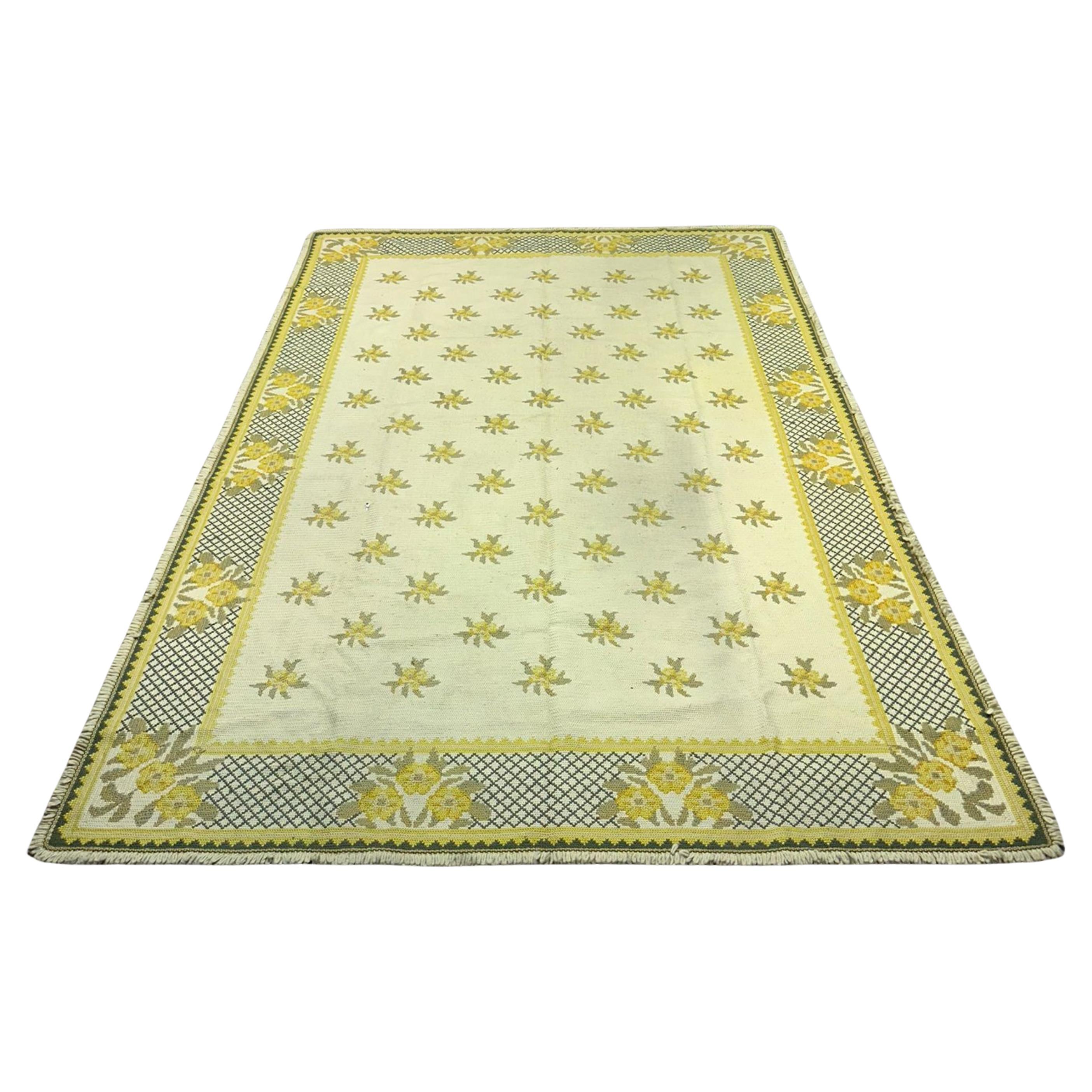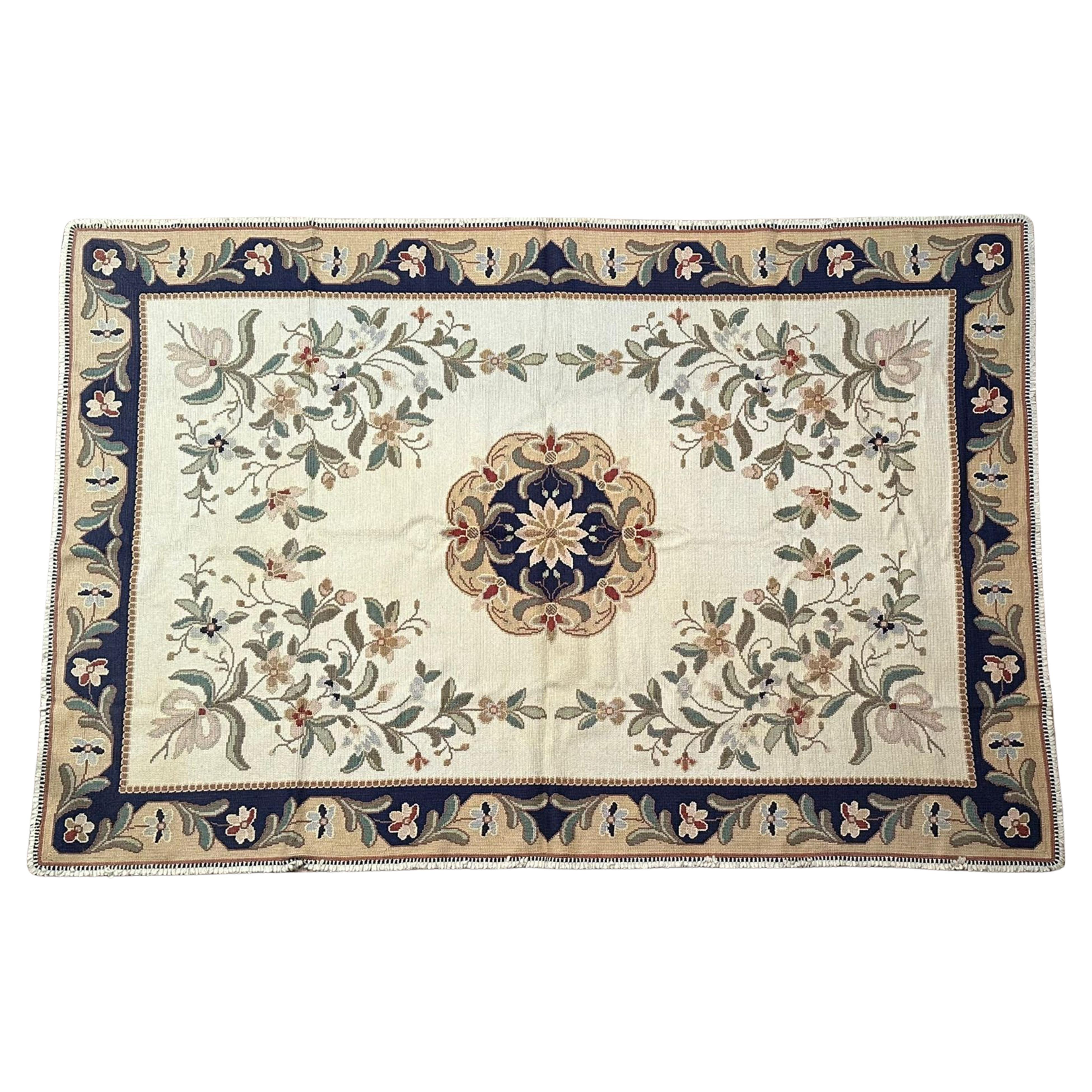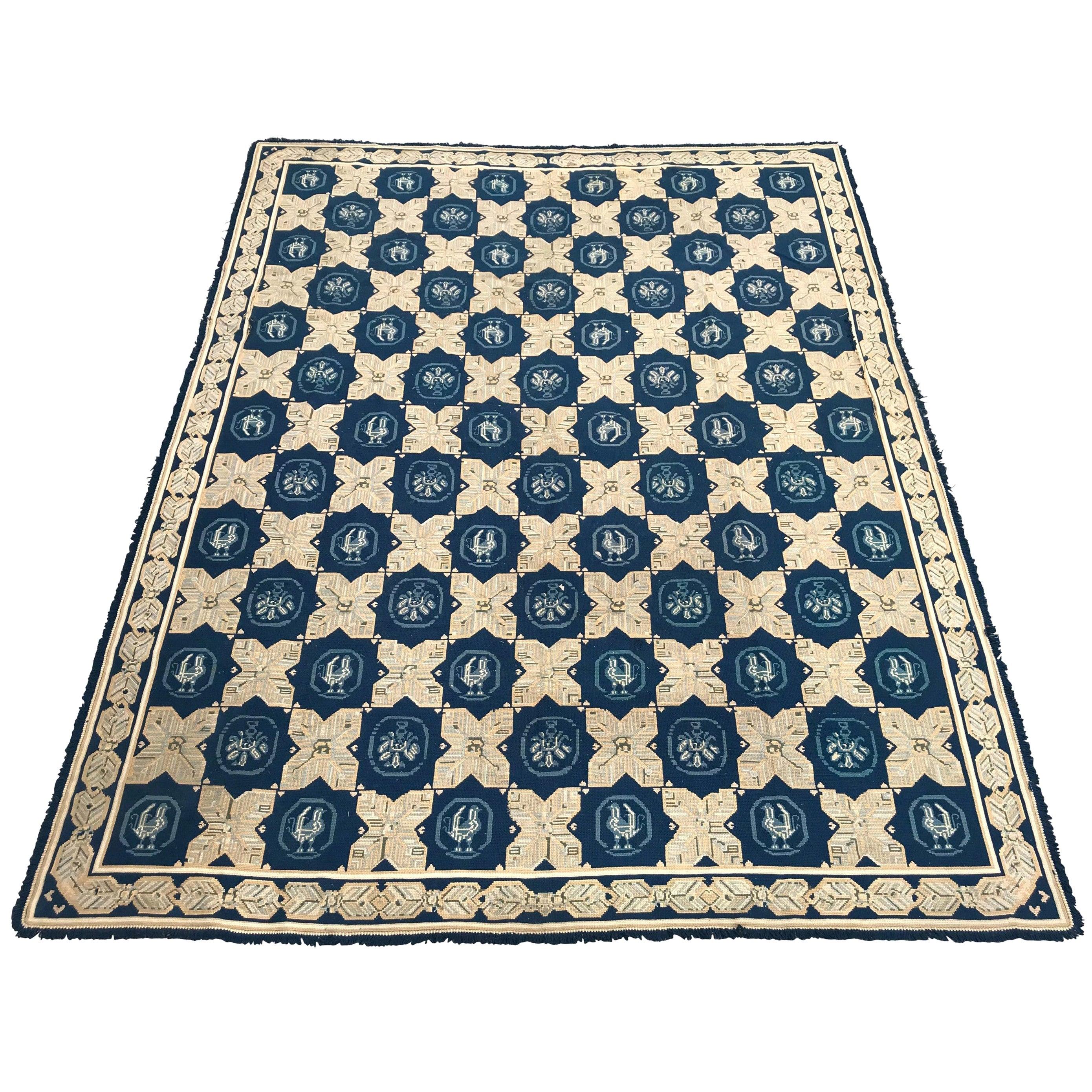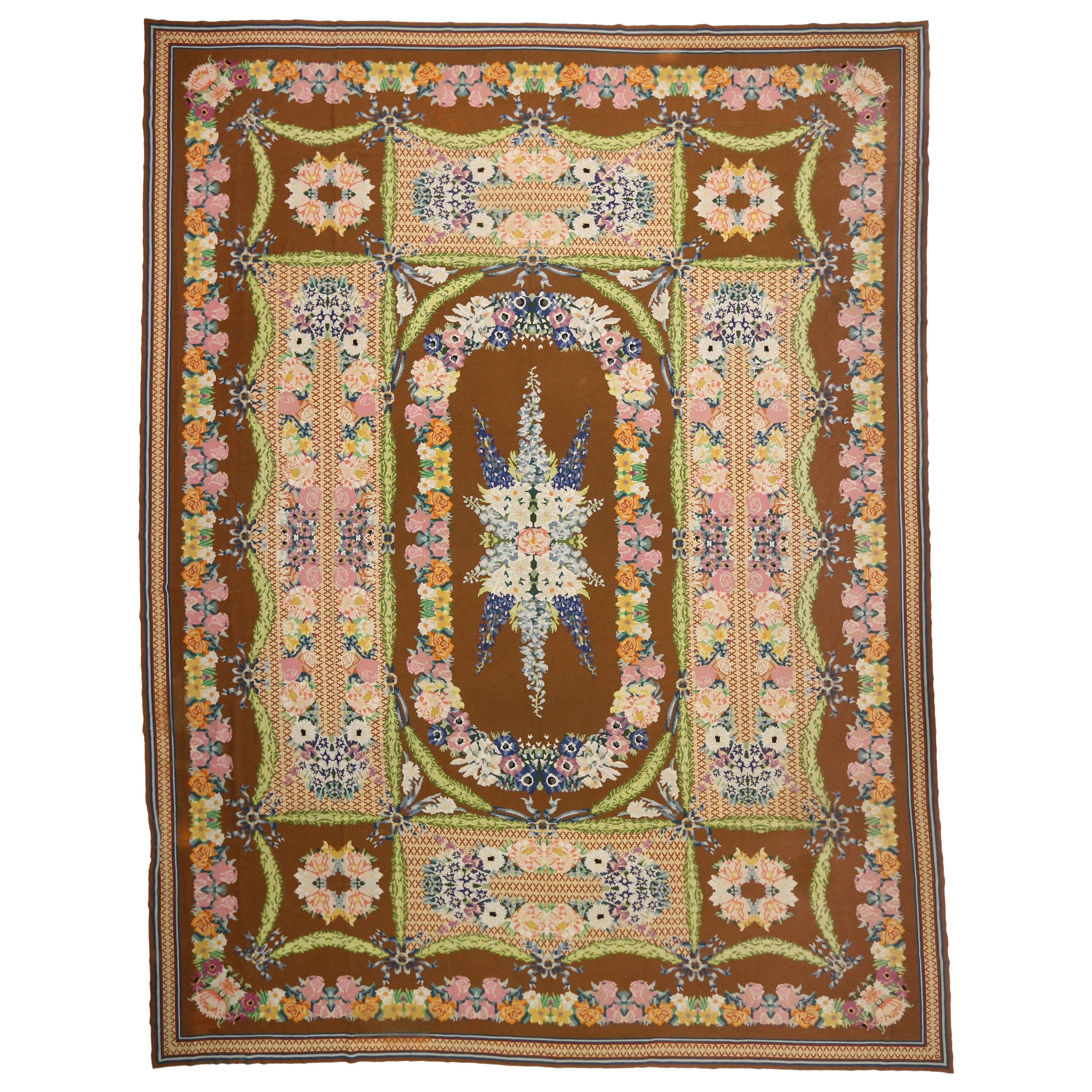Items Similar to XIX Century Portuguese Arraiolos Tapestry
Video Loading
Want more images or videos?
Request additional images or videos from the seller
1 of 11
XIX Century Portuguese Arraiolos Tapestry
About the Item
The Arraiolos Tapestry, also known as Arraiolos Embroidery, is a traditional Portuguese needlework technique that originated in the town of Arraiolos, located in the Alentejo region of Portugal. It is characterized by intricate woolen stitches embroidered onto a canvas or cloth background to create geometric patterns, floral motifs, and sometimes pictorial scenes.
The history of Arraiolos Tapestry dates back several centuries, with its origins rooted in the medieval period. It gained prominence during the Renaissance and Baroque eras when it became popular among Portuguese nobility and aristocracy as a decorative art form for furnishing palaces and estates.
Arraiolos Tapestry is typically worked on a base fabric made of linen or jute using wool yarn. The embroidery stitches used in Arraiolos include the tent stitch, also known as the Arraiolos stitch, which is a diagonal stitch that covers the canvas in a uniform manner, creating a dense and durable surface.
Traditional designs often feature geometric patterns such as diamonds, squares, and triangles, as well as stylized floral motifs inspired by nature. These designs are often passed down through generations, with each piece reflecting the artistic style and cultural heritage of the region.
Today, Arraiolos Tapestry continues to be practiced as a traditional craft in Portugal, with artisans preserving and adapting its techniques to contemporary tastes. It is valued not only for its aesthetic beauty but also for its cultural significance as a symbol of Portuguese craftsmanship and heritage. Arraiolos Tapestry pieces are sought after as decorative items, and they are also cherished as heirlooms that showcase the rich tradition of Portuguese textile artistry.
- Dimensions:Width: 83.47 in (212 cm)Length: 124.02 in (315 cm)
- Materials and Techniques:
- Place of Origin:
- Period:
- Date of Manufacture:c.1850
- Condition:Wear consistent with age and use.
- Seller Location:Lisboa, PT
- Reference Number:1stDibs: LU7365238305262
About the Seller
5.0
Vetted Seller
These experienced sellers undergo a comprehensive evaluation by our team of in-house experts.
Established in 2018
1stDibs seller since 2022
10 sales on 1stDibs
Typical response time: 13 hours
- ShippingRetrieving quote...Ships From: Lisboa, Portugal
- Return PolicyA return for this item may be initiated within 14 days of delivery.
More From This SellerView All
- XIX Century Portuguese Tile PanelLocated in Lisboa, PTXIX Century Portuguese Altar front Tile Panel with 44 Tiles Altar fronts were rectangular tile panels that covered the part of the altar facing the faithf...Category
Antique Late 19th Century Portuguese Decorative Art
MaterialsClay
- XIX Century Portuguese Peasent Woman, Oil on CanvasLocated in Lisboa, PTThis magnificent painted oil canvas, depicts an anonymously beautiful peasant women on a lush surrounding of forest and bushes. Portuguese intelectual work of as well an anonymous p...Category
Antique Mid-19th Century Portuguese Paintings
MaterialsCanvas
- XIX Century Portuguese from a Convent Hand Painted and GildedLocated in Lisboa, PTConvent benches, also known as choir stalls or monastic benches, are long wooden benches typically found in the choir area of convents, monasteries, and...Category
Antique 19th Century Portuguese Benches
MaterialsWood
- XIX Century Rosewood breakfast tableLocated in Lisboa, PTIn 19th century England, the Breakfast rosewood table emerged as a symbol of refinement and opulence. Crafted with meticulous attention to detail, its surface is adorned with a venee...Category
Antique 19th Century English Dining Room Tables
MaterialsRosewood
- Old Neoclassic Golden Mirror - XIX Century - EuropeLocated in Lisboa, PTThis intricated detailed Neoclassic golden wood mirror is a testatment to good taste that it is still relevant on the XXI Century. Offering possibilities of different placement this...Category
Antique 19th Century European Neoclassical Wall Mirrors
MaterialsGlass, Wood
- XIX Century Newfoundland Labrador Sculpture (Devezas Ceramics)Located in Lisboa, PTThe Newfoundland Labrador dog, commonly referred to as the Newfoundland or Newfie, is a large and strong breed known for its gentle and sweet nature. It originated from the Canadian province of Newfoundland and Labrador, where it was originally bred as a working dog for tasks such as hauling fishing nets, pulling carts, and rescuing people from water. Key characteristics of the Newfoundland breed include its massive size, with males typically weighing between 130-150 pounds (59-68 kg) and females between 100-120 pounds (45-54 kg). They have a thick double coat that is water-resistant, which helps them excel in water activities and also provides protection in cold climates. The coat can come in various colors, including black, brown, gray, and Landseer (white with black markings). Newfoundlands are known for their gentle and calm demeanor, making them excellent family pets and great with children. They are often described as "gentle giants" due to their patient and affectionate nature. Despite their size, they are generally good-natured and friendly with strangers and other animals. These dogs require regular grooming due to their thick coats, and they also need moderate exercise to stay healthy and happy. They enjoy activities like swimming, hiking, and participating in water sports. Additionally, early socialization and training are important to ensure they grow up to be well-behaved companions. Overall, the Newfoundland Labrador dog is a beloved breed known for its loyalty, gentle nature, and versatility in various roles, from family pet to working dog. The Fábrica de Cerâmica das Devesas (Devesas Ceramic Factory) was established in Vila Nova de Gaia in 1865 and was, at the time, one of the largest and best equipped producers of ceramics.[1] Founded by António Almeida e Costa...Category
Antique Mid-19th Century Portuguese Animal Sculptures
MaterialsPorcelain
You May Also Like
- Portuguese Arraiolos RugLocated in New York, NYPortuguese Arraiolos rug Portugal, circa 1960 Handwoven.Category
Mid-20th Century Portuguese Western European Rugs
MaterialsWool
- Beautiful Portuguese Rug " Arraiolos " 20th CenturyBy Europa AntiquesLocated in Madrid, ESBeautiful Portuguese Rug " Arraiolos " 20th Century hand made in wool 307cm x 200 like newCategory
20th Century Portuguese Modern Western European Rugs
MaterialsWool
- Beautiful Portuguese Rug " Arraiolos " 20th CenturyBy Europa AntiquesLocated in Madrid, ESBeautiful Portuguese Rug " Arraiolos " 20th Century hand made in wool 297cm x 200cm like newCategory
20th Century Portuguese Modern Western European Rugs
MaterialsWool
- Bobyrug’s Wonderful Large Antique Flat Portuguese Arraiolos Needlepoint RugLocated in Saint Ouen, FRDiscover the elegance of our early 20th-century Portuguese needlepoint Arraiolas rug. Adorned with a captivating geometrical Victorian design in soothing blue and beige hues, this ex...Category
Early 20th Century Portuguese Victorian Western European Rugs
MaterialsHemp, Cotton, Wool
- 1930s Portuguese Arraiolos Needlepoint Carpet ( 14'2" x 23' - 432 x 702 )Located in New York, NY1930s Portuguese Arraiolos Needlepoint Carpet ( 14'2" x 23' - 432 x 702 )Category
Vintage 1930s Portuguese Western European Rugs
MaterialsWool
- Antique Portuguese Aubusson Arraiolos Rug, French Romanticism Meets MaximalismLocated in Dallas, TX77321 Antique Portuguese Arraiolos Rug, 16'03 x 21'05. French Romanticism meets Maximalism in this oversized antique Portuguese Arraiolos needlepoint rug...Category
Antique Late 19th Century Portuguese Aubusson Western European Rugs
MaterialsWool





